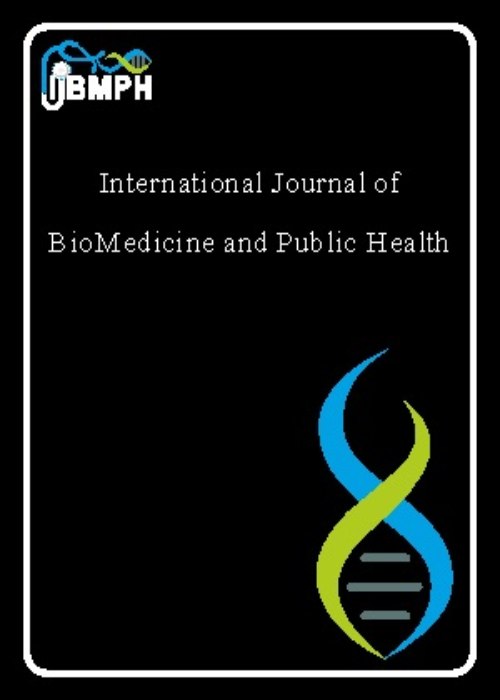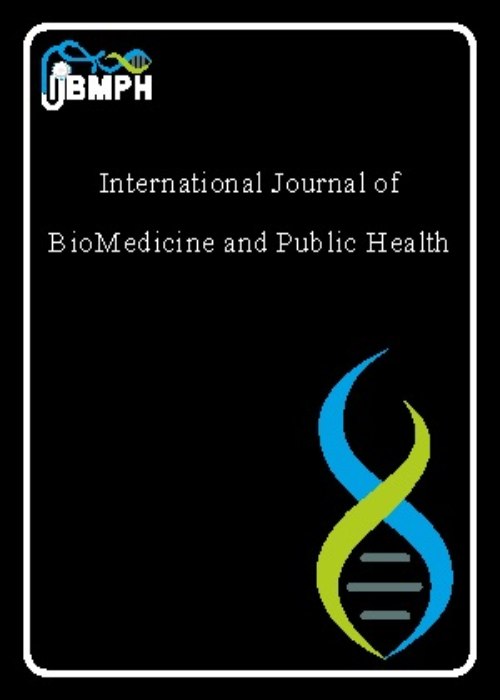فهرست مطالب

International Journal of Biomedicine and Public Health
Volume:2 Issue: 4, Winter 2019
- تاریخ انتشار: 1397/12/10
- تعداد عناوین: 6
-
Pages 1-7IntroductionNurses form build up the greatest portion of health care providers and play a central role in maintaining medical care. Determining the clinical competence level of nurses is an important issue in maintaining standards of care, identifying the educational needs and professional development of nurses. Therefore, the aim of this study was to determine the clinical competency level of nurses who work in Kermanshah University of Medical Sciences affiliated hospitals, in 2014.MethodsThis cross sectional study was conducted on 204 nurses working in five educational hospitals affiliated to Kermanshah University of Medical Sciences. Samples were selected based on cluster randomization. The study instruments included demographic information questionnaire and Benner Clinical Competence Questionnaire (CCQ). Data analysis was performed using the SPSS v 16 software.ResultsThe mean and standard deviation for age and work experience of the subjects were 33.55 ± 6.17 and 9.31 ± 5.74 years, respectively. The mean and standard deviation of the total clinical competency score was 69.56 ± 10.74. The mean score for helping the patient component was 68.11 ± 14.06, training and guidance component was 69.81 ± 11.63, diagnostic measures component was 70.65 ± 15.5, management skills component was 71.04 ± 12.63, therapeutic measures component was 70.56 ± 12.47, quality assurance was 68.32 ± 14.59, and occupational and organizational tasks component was 70.85 ± 11.81.ConclusionThe clinical competence of most samples was categorized as good. According to the results of this study, researchers suggest that clinical competency assessment of nurses should be programmed and performed annually.Keywords: Nurses, Clinical Competency, Hospitals
-
Pages 8-13IntroductionIntegrin and chemokine receptors play an important role in leukocytes migration and recirculation during autoimmune disorders including rheumatoid arthritis (RA). Normally, gut-homing T cells express CCR9 and integrin α4β7 in order to home back from peripheral blood to the intestinal lamina propria. Our study was conducted to evaluate the chemokine receptor CCR9 and the integrin α4β7 gene expression in circulating leukocytes and lymphocytes among newly diagnosed RA patients and to compare these values with healthy individuals.MethodsIn this case-control study, 20 newly diagnosed patients with RA and 20 healthy controls were examined. Peripheral blood samples were acquired from patients and healthy individuals. The total RNA was extracted, then cDNA synthesis was performed. The expression of CCR9 and β7 genes were evaluated by quantitative real-time PCR. The t-test was used to compare gene expression between the groups.ResultsWe found that RA patients had a significantly higher level of β7 gene expression compared to controls (P=0.007), while there was no significant difference in CCR9 gene expression between 2 groups (P=0.06).ConclusionOur data showed that the expression of β7 gene increases in RA patients and, similar to IBD, β7 gene can be a candidate target for therapy in RA patients.Keywords: Rheumatoid arthritis, Chemokines, Integrins, Gene expression
-
Pages 14-19IntroductionBrucellosis is one of the most common zoonosis diseases that can be seen in many developing countries, including Iran. The aim of this study was to determine the prevalence of brucellosis in Isfahan province.MethodsThis is a cross-sectional study in which all newly reported cases of brucellosis in Isfahan city in 2016 were studied. Sampling was done through numerical method. The statistical tests used in this study were one-way ANOVA and two-sample T-test.ResultsThe incidence rate of brucellosis in Isfahan province in 2016 was 19.78 per 100,000. Majority of cases (590, 67.8%) were men with a mean age of 31.62 ± 20.04 years old and 32.2% (280 cases) were women with a mean age of 33.35 ± 20.26 years old. Friedan had the highest incidence rate of brucellosis (204.47 per 100,000) while Isfahan had the lowest incidence rate (1.81 per 100,000). There was a significant relationship between occupational variables (P = 0.001), history of contact with the livestock (P = 0.0001), non-pasteurized dairy consumption (P = 0.0001), and the incidence of the disease (P = 0.003) in urban and rural areas.ConclusionThe incidence rate of brucellosis in Isfahan is classified as a very low. The disease is more common in rural areas than in urban areas. Therefore, educational, preventive and therapeutic measures in rural areas, particularly in those involved with animal husbandry and homemaking, have priority over urban areas.Keywords: Brucellosis, Epidemiology, Iran
-
Pages 20-26IntroductionEvery year, many workers lose their lives or suffer serious injuries due to various workplace accidents, and it is essential to investigate and identify hazards to prevent accidents. Therefore, the purpose of the current study was to investigate occupational hazards using job safety analysis and inspecting the changes in identification of hazards in a cement industry.MethodsThis cross-sectional study was conducted in 2017. Fifteen critical job positions that bear potential health threats were identified in a cement factory in Fars province. The hazards of each position were investigated using job safety analysis and inspecting the changes.ResultsThe highest scored cause of accidents among the evaluated hazards was human error with the score of 37.1%. Economic outcomes (56.1%) was rated higher compared to human and environmental outcomes and human causes (58.9%) was rated higher compared to management, design, and structural reasons. Furthermore, management changes (55.3%) prioritized design and structural changes.ConclusionThe change analysis is a powerful way to reveal the contemporary defects in an organization or system, and can be used to identify deficiencies and hazards, ways to fix the defects and the scope of the problem. Executing the specified changes, remarkably improves the safety of the organization and controls the existing hazards.Keywords: Change analysis, Job safety analysis, cement industry
-
Pages 27-31IntroductionSnake venom L-amino acid oxidase (SV-LAAO) has promising therapeutic prospects because of its effects on various biological functions. Purified Naja naja venom enzyme L-amino acid oxidase (NnLAAO) was studied to examine its anticoagulant and cytotoxic properties.MethodsActivated partial prothrombin time (APPT) assay and prothrombin time (PT) both of these assays are used to access the anti-coagulant property of NnLAAO on human blood sample. Sulforhodamine B (SRB) protocol is performed on MDA MB-231and HCT 116 cell, which are treated with different doses (0.4µg-100µg) of NnLAAO for 48h incubation time, respectively, and the percentage of inhibition was compared with oxaloplatin as positive control.ResultsNnLAAO significantly prolonged the APPT and showed a negligible effect on the PT. NnLAAO inhibited cytotoxicity in a dose-dependent manner in both breast cancer MDA MB-231 and colon adenocarcinoma (HCT-116) cell lines with 60% and 78% of inhibition respectively.ConclusionThe NnLAAO enzyme of Indian cobra venom is a promising anticoagulant as well an anticancer agent for various cell lines because of its efficiency and specificity, as it will offer better treatment and response with fewer side effects.Keywords: L-amino acid oxidase, anticoagulants, Cytotoxic, HCT-116
-
Pages 32-36IntroductionEscherichia coli (E. coli) bacteria are a common cause of various clinical infections. Resistance of this bacteria to several common antibiotics due to production of extended spectrum beta-lactamase (ESBL) enzyme has caused therapeutic problems. The aim of this study was to determine the resistance pattern to beta-lactam antibiotics and also to assess the Temorina (TEM) gen in the E. coli strains isolated from the patients in Babol, Iran.MethodsThis cross-sectional study was conducted in 2014 at Babol County, Iran. The E. coli strains were isolated and identified by standard laboratory tests. The sensitivity test to beta-lactam antibiotics was performed by combined disk method. The TEM gene was identified in the resistant strains by the polymerase chain reaction (PCR) method. The data were analyzed by SPSS 20 and by using t-test and Chi2 tests.ResultsOf the 10341 clinical samples, 525 E. coli isolated of which 200 (38%) were ESBL-producing strains. Piperacillin-tazobactam, amikacin, ampicillin-sulbactam and ampicillin (98%, 90.33%, 86.4% and 76.60%, respectively) had the most inhibition effect on the strains. Highest antibiotic resistance was observed for ceftriaxone (43.80%) and ciprofloxacin (38.74%). PCR showed that 80% (N=160) of the resistant strains had the TEM gene. There was a statistically significant correlation between TEM gene and the production of ESBL (P<0.05).ConclusionResistance to antibiotics was observed in this study. Resistant and ESBL-producing strains of E. coli had TEM gene. The clinicians should be aware of antibiotic resistant pattern to choose effective medicines for treatment of these infections.Keywords: E. coli, Antibiotic resistance pattern, Extended-spectrum beta-lactamase, Temorina


